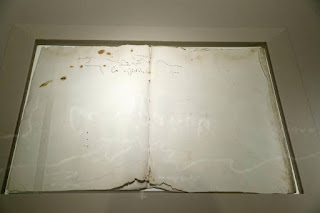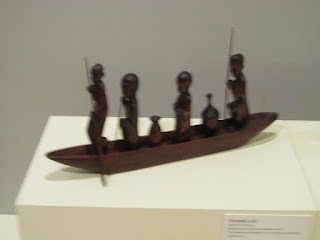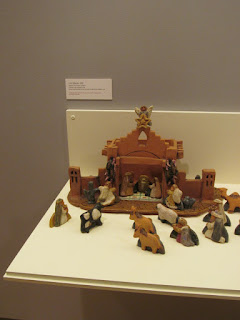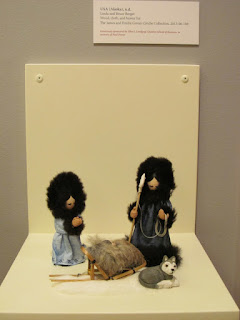MEADOWS MUSEUM
25 November 2015
The Watermere bus with Raul at the wheel
left the clubhouse at 9:30 for a trip to the Meadows Museum in Dallas to view the Treasures from the Hous of Alba exhibit. We were interested because
it was the first time many of these objects had been exhibited and/or traveled
outside Spain. The items on exhibit were somewhat heavy on family portraits for
our taste. That being said, we enjoyed seeing them. The 140 items included
papers of Christopher Columbus,
Columbus’ Logbook
the Alba Family Bible
and
works by Goya,
Duchess of Alba in
White by Goya
Rembrandt,
Chagall, Sergeant, Velzaquez and others. There were also a few pieces of
furniture
and
some tapestries.
Photos
were not allowed inside the museum, but some of included items were found
online. After lunch, we went to Kuby’s
in Snider Plaza for lunch. After
lunch, we bought some lebkuchen and stollen in the market at the restaurant.
We arrived back at Watermere shortly
after 2:00.
Girl with Hat with
Cherries by Renoir
There was also a Fra Angelico Madonna, which they called the
high point of the collection.
EXHIBITION
INFORMATION
Treasures from the House of Alba: 500 Years of Art and
Collecting features more than 100
works—from paintings by Goya and Rubens to 16th-century tapestries by Willem de
Pannemaker and 19th-century furniture created for Napoleon III—most of which
have never been seen outside of Spain, as well as illuminated
manuscripts, books, historic documents, miniatures, antiquities, prints,
sculpture, drawings, and other objects.
The House of Alba — for centuries the most illustrious household
in Spain, with close ties to the monarchy — remains one of the foremost noble
families in Europe, with roots dating back to the mid-15th century when
Fernando Álvarez de Toledo was named Count of the town of Alba de Tormes. The
Albas have since forged connections with members of some of the most prominent
dynasties in European history, including the House of Stuart; the Count-Dukes
of Olivares; the Duchy of Veragua, (descendants of Christopher Columbus);
Napoleon III and his wife, Eugenia de Montijo; and the Churchill family.
Over the past five centuries, the Alba family’s patronage,
connoisseurship, and ties to Western royalty have shaped the growth and
trajectory of the Alba collection, which is now one of the greatest private
collections in the world. Until her passing in November 2014, the head of the
Alba family was Cayetana Fitz-James Stuart, the 18th Duchess of Alba, who
bore more recognized titles than any other noble today. She is succeeded
by her son, Carlos Fitz-James Stuart y Martínez de Irujo. In the following
photo the 19th Duke of Alba is on the right and the director of the Meadows Museum is on the left. They
portraits on the wall are of the 16th and the 17th Dukes
of Alba.19t19th Duke of Alba (right), pictured with Meadows Museum
director 17th Dukes of Alba.
“Our will is to share the works and pieces that make up the
collection of the House of Alba Foundation with a public that is increasingly
knowledgeable and more interested in culture and history,” said Carlos
Fitz-James Stuart y Martínez de Irujo, Duke of Alba. “This selection of objects
allows us to present different works and documents that have survived the
vicissitudes of history and represents the greatest treasure of the legacy of
our family. It is also an extraordinary opportunity for making the public aware
of the steady and silent work of preservation and upkeep that the House of Alba
has been doing for centuries.”
THE
ALBA FAMILY
For more than five hundred years, the Alba family has formed part
of the most important aristocratic lineages in Europe, not only because of its
military, political, and social significance, but also due to the relevance of
its cultural patronage and its art collecting. Treasures from the House of
Alba: 500 Years of Art and Collecting will display some of the finest
examples from this collecting tradition, from the fifteenth and sixteenth
centuries up to the end of the twentieth century, in a display of continuity
unparalleled by other large European collections.
Currently, the Alba family keeps its collections of paintings,
sculptures, antiquities, furniture, tapestries, and all types of decorative art
in three splendid palaces that historically belong to the lineage. The first of
them is the Liria in Madrid, a building from the eighteenth century designed by
Ventura Rodriguez, the interiors of which, destroyed in the civil war, were
beautifully reconstructed by Sir Edwin Lutyens in the middle of the twentieth
century; the second palace is the Dueñas in Seville, a magnificent
Renaissance/Mudejar construction from the sixteenth century, the most important
in this style preserved in Spain; the third is the splendid Monterrey in
Salamanca, a masterpiece of the Spanish Renaissance, designed by Rodrigo Gil de
Hontañón in the middle of the sixteenth century.
These three buildings, of which the first two possess
beautifully and perfectly maintained gardens, house the aforementioned
collections, made up of thousands of pieces signed by, among many others, the
following artists: Fra Angelico, Titian, Bassano, Van Gogh, Goya, Ribera,
Murillo, Rubens, Rembrandt, Brueghel, Guardi, Reynolds, Mengs, Ingres, Renoir,
Courbet, Madrazo, Zuloaga, and Sargent.
The exhibition displays a broad selection of works by these
artists that, as such, are leaving Spain for the first time and groups them,
also for the first time, in a manner that explains the historical development
of the family and the collection from the end of the fifteenth century to the
present day. It is the first exercise in the understanding of the history of
this family, shown through a vast display of more than 130 objects.
The exhibition will be presented thematically, with sections
marking significant periods of collecting within the history of the family.
“Knights, Soldiers, Courtiers: The Great Duke of Alba in the Service of the
Monarchy” looks at the origin of the dynasty, and in particular Don Fernando
Alvarez de Toledo, the 3rd Duke of Alba and a central figure of sixteenth
century Europe. This central figure of sixteenth century Europe, was a
prominent noble, general and diplomat, best known as the Great Duke of Alba. An
adviser to both King Charles I of Spain and Philip II of Spain, Alba was known
for his loyalty to the Monarchy. The family’s early fifteenth-century bible, an
illustrated manuscript comprised of 513 folios, will be a featured in this
section.
“Magnificence and Power: The Baroque Collection of the Alba
Family in the Golden Century” focuses on the House of Alba’s connection to the
families of Monterrey, Veragua and, above all, Carpio, great collectors of
European Baroque paintings, a large part of whose collections were passed on to
the Duchy of Alba, among them the extremely important series of Christopher
Columbus documents – manuscripts in the explorer’s hand showing his very first
map of the New World and listing the sailors accompanying his voyage – and a
fine Flemish tapestry by Willem de Pannemaker.
The Stuart family, descending in a direct line from James II of
England/James VII of Scotland, through the Duke of Berwick, became related to
the Bourbon family and the Alba lineage in an ever-increasing manner starting
in the early eighteenth century. A large part of the portraits from this
century owe their origin to this union; “Stuart-Berwick-Alba: The Union of Two
European Lineages in the Eighteenth Century” will present highlights from this
period.
“Francisco de Goya and the Duchess of Alba” concentrates on the
famous Duchess Doña Teresa Cayetana, number thirteen in the lineage, whose
portrait was painted many times by Francisco de Goya y Lucientes (1746-1828).
She died without descendants, and the Alvarez de Toledo surname was lost. The
Berwick family then inherited the title, and the family went on to carry the
Fitz-James Stuart surname, which they retain. The relationship between Doña
Teresa and Goya and its fantastic artistic results, as well as the change in
the family with regard to estates and properties, makes this the central time
period of the exhibition.
In the early nineteenth century, with the family having lost a
large part of its historic collections, Duke Carlos Miguel was the one who
decided to reconstruct the collection, as a private studio and, at the same
time, as a painting and sculpture gallery. A learned nobleman, he embarked on a
Grand Tour of Europe and accumulated an immense collection of canvasses,
sculptures, pictures, drawings, and antiquities, forming the basis of what is
currently kept in the Berwick-Alba collections. Highlights from “The European
Collection of Carlos Miguel Fitz-James Stuart, Duke of Berwick and Alba”
include a moving painting by Jusepe de Ribera (1591-1652), Crowning with
Thorns (c. 1620), and a self-portrait by Anton Raphael Mengs (1728-1779).
Another very important part of the collection comes from the
legacy of Eugénie de Montijo, Empress of France and wife to Napoleon III,
sister-in-law and aunt to two Dukes of Alba. Upon her death in Madrid in 1920,
her collections of paintings, furniture, and works of art were passed on to the
latter of the two dukes, Don Jacobo Fitz-James Stuart y Falcó, the 17th Duke of
Alba and father of the current duchess. A noblewoman of Andalusian origins and
Empress of France, her collections featured in “Seville-Paris-Madrid: The
Empress Eugénie de Montijo and the House of Alba” reflect her taste for a
romantic image of Spain, in addition to the Neo-Baroque of the Second Empire.
Examples include a delicate fan bearing her likeness and a stunning gilt table.
In the final section of the exhibition, “Great Portraits and the
Contemporary Collection: Jacobo Fitz-James, 17th Duke of Alba, his Daughter
Cayetana, 18th Duchess of Alba and the Arts,” the family’s collecting activity
is a very important episode. The acquisitions of the 17th Duke of Alba, Jacobo,
and his daughter, Cayetana, who bore the title until her passing in November
2014, include works by classic artists such as Rubens and Antonio Moro; modern
works by Spanish artists such as Zuloaga, Benlliure and Sert; and works by
foreign artists such as Guardi, Reynolds, Renoir, Fantin-Latour, Courbet,
Boudin, and Picasso. The reconstruction of the Liria Palace in the middle of
the twentieth century and the current splendor of the collections are thanks to
their efforts.





















































































































